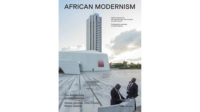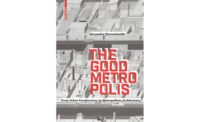This handsome book is a culmination of a series of exhibitions held in Massachusetts; London; Bern, Switzerland; Lisbon; and Tokyo that showcased architect David Adjaye’s photographic survey of Africa’s urban environment.
Six of the seven paperback volumes in this boxed set, edited by Peter Allison, consist of pictures of the diverse architectural forms that exist on the continent. The author, who was born in Tanzania but practices in London, should be commended for attempting to document Africa so thoroughly. The book serves as a visual archive for architects, urban planners, and architectural historians interested in the continent’s built environment.
The decision to assemble the pictures on the page in multiple rows, like courses of masonry blocks, adds to the architectonic quality of the book. The photographs vary in size and dimension, preventing a visual monotony that would have resulted from displaying pictures of similar dimensions on every page. Also, the decision to leave the photographs unlabeled allows the buildings and streetscapes to speak for themselves. However, this omission makes it hard for readers to learn more about the architects or clients of the buildings.
The seventh volume contains essays by various authors who discuss topics such as the history of the metropolis in Africa, cultural production, security, and intertribal conflicts. Contributors include Kwame Anthony Appiah, who teaches philosophy at Princeton; cultural historian and filmmaker Nana Oforiatta Ayim; curator and critic Okwui Enwezor; architect Naigzy Gebremedhin; and Suzanne Preston Blier, who teaches fine arts and African studies at Harvard. These essays, which are published without illustrations, explain how the built environment continually shapes the topics being addressed—and vice versa.
Perhaps a subsequent edition of the book could incorporate visual documentation along with the essays. This would be especially helpful with Blier’s piece, “The African Urban Past: Historical Perspectives on the Metropolis,” which examines precolonial African cities. Placing the visual archive alongside the text would help trace the evolution of the city in Africa.
Each of the six illustrated volumes looks at a different African ecosystem, providing a simple way of organizing a large and diverse continent. The volumes are: the Maghreb (northwest Africa), Desert, the Sahel (the semi-arid fringe south of the Sahara), Forest, Savanna and Grassland, and Mountain and Highveld. One advantage of this arrangement is that descriptions of the architecture and monuments of different cities are placed side by side in one volume, allowing the reader to compare built works in cities with similar climatic conditions. A short history of each city precedes its visual documentation, serving as an introductory guide to the place. Pictures of kiosks are placed alongside municipal, residential, and commercial buildings, furthering Adjaye’s argument that the designs of small-scale structures can inspire local architectural solutions in larger building types.
I would like to see photographs of some of the buildings’ interiors in a subsequent edition, which would help elucidate the design decisions that are not apparent from just the exteriors. Nevertheless, Adjaye and the contributing essayists should be commended for creating a cultural and visual history of Africa’s urban environment that is unprecedented; it fills a void in the field of architectural history as a whole.









